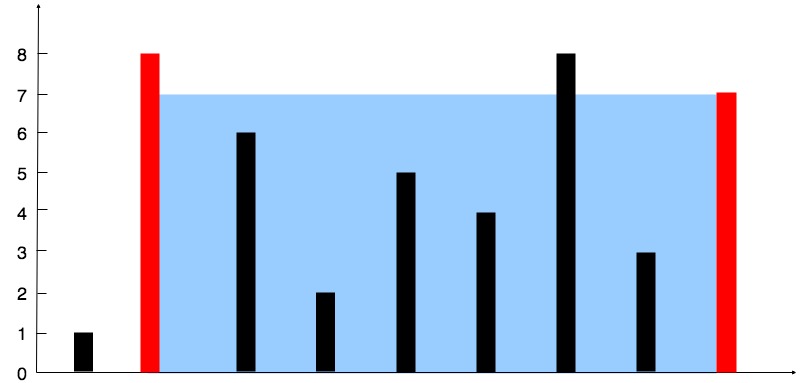题目
Given n non-negative integers a1, a2, …, an , where each represents a point at coordinate (i, ai). n vertical lines are drawn such that the two endpoints of line i is at (i, ai) and (i, 0). Find two lines, which together with x-axis forms a container, such that the container contains the most water.
Note: You may not slant the container and n is at least 2.

The above vertical lines are represented by array [1,8,6,2,5,4,8,3,7]. In this case, the max area of water (blue section) the container can contain is 49.
Example:
1 | Input: [1,8,6,2,5,4,8,3,7] |
解题报告
题意很简单,看图就可以猜出大概是要找出黑柱能装下的最大容量。
题目提示是使用双指针,我就先搞了个 begin,end作为两个黑柱,刚开始是想着两个指针同时从头开始遍历,begin 只有在 $height[end] > height[begin]$ 时才更新,而 end 每次迭代都 +1,但是发现光是题图就不能得出答案。
于是想着既然同一方向不行,那就两个指针相向而行。同时我确认了一个原则:尽可能保留高的柱。刚开始我写的是:每次迭代都让下一位置较大的指针移动,即
1 | if (height[end - 1] > height[begin - 1]) --end; |
发现还是 a 不掉,于是想到,既然我要保留高的柱,我为什么要比较下一个柱子,我应该直接比较当前柱子呀。试了一下,a 掉了。
为什么是这样做呢
我认为 begin,end 始终在靠近对方,而当柱子高度相同时,距离越近,最大容量显然越小,所以应该尽可能保留“远处”的高柱子。
当然,其实当一个指针 i 不动时,我们是在找以 height[i] 为两个柱子其中之一的最优解,当我们找到另一个更高的柱子 height[j] 时,就意味着最高容量为 $maxArea = height[i] * |i - j|$。此时就算 j 的下一个柱子更高,也不会改变最大容量,甚至会因为更靠近 i 使得容量减少。
更一般的说,当 $min \left \lbrace height[i], height[j] \right \rbrace$ 固定时,即使另一个柱子再高,也不会更新最大容量,反而会逐渐减少,所以每次迭代时都是让较矮的柱子改变。
另外,容易想到,当其中一个柱子 i 变高之后,与另外的柱子之前的柱子组合起来也不会使 i 的最大容量变得更大,这里不再说明。
Solution
1 | class Solution { |
评论